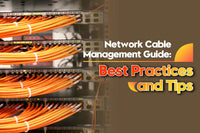Contents
Data centers play a pivotal role in the operations of daily life. With so much of our lives being online, the growing need for data centers continues at an exponential rate. For professionals new to the craft, data centers have different needs when it comes to network cabling. Structured cabling for data centers relies on a few different components that help maintain throughput, cohesion, and ultimately provide less downtime.
With that in mind, let’s take a closer look at some of the requirements associated with structured cabling in a data center. A structured cabling system isn’t something you’ll design on a whim, but rather something with serious thought and research guiding the decision-making process.
What Is Structured Cabling?
Structured cabling for data centers is a systematic approach to designing networks for data centers. When considering the thousands of potential endpoints needed for connecting all relevant network equipment, the structured approach makes a lot of sense. You’re providing extensive documentation for an organized and coherent network topology. Further, a structured cabling system follows standardized practices for both the sake of compliance and overall safety.
Structured cabling is paramount for the continued operations and overall safety of any network configuration. Consequently, a structured system is far easier to maintain and scale than its unstructured counterpart. Unstructured cabling systems typically rely on point-to-point connections and can quickly become a snarl of thousands of unmarked cables.
Structured Cabling Hardware Requirements
As you might imagine, it isn’t a simple installation process when considering structured cabling for your data center. Depending on the size and layout of your data center, there are some considerations you’ll have to keep in mind in terms of the cabling itself. You’ll likely have to consider what sort of cabling you’re using, with twisted pair copper core or fiber optic cables being the most common choices for modern data centers.
If you’ve got multiple stories to consider, then you’ll need to consider vertical cabling. Connectors are also paramount when considering the layout and structure of your cabling. If you’re sticking to CAT6 or newer ethernet cables, these will be terminated with a T568A or B connector. Fiber optics are a bit more mixed in terms of standardization, but you’ll likely see the LC and SC connectors for high-density cable deployments.
Ideally, your cables will be routed to a patch panel. This aids setup with the proper documentation and labeling, and should make replacing faulty lengths of cable a cinch. Naturally, you’ll be dealing with routers and switches, but that shouldn’t come as a surprise to even a new network technician.
Components of Structured Cabling for Data Centers
There are four major components of structured cabling for data centers that you’ll want to keep in mind before designing your system. These aren’t universal by any means, but these do provide a solid framework for designing your data center’s network. The components are as follows:
- Organization
- Compliance Requirement
- Scalability
- Maintenance
Let’s take a closer look at why you’ll want to keep these components in mind when designing your structured cabling system.
Organization
The cornerstone of any structured cabling worth its salt is organization. Cabling is labeled, color-coded, and ultimately effectively managed thanks to the likes of patch panels and cable trays. This has a few distinct benefits. Primarily, when a cable fails, you can pinpoint and quickly address the point of failure.
Additionally, a color-coded, organized, structured cabling system is far easier to maintain for other personnel. Typically, you’ll have a fair amount of documentation on hand during the creation of the system. Documentation is key when considering both long-term maintenance and scaling your network operations as needs grow.
Compliance Requirements
Compliance and regulations are part and parcel of doing business in the modern world. There are some standards that you’ll likely have to adhere to when designing your structured cabling. Common compliance standards include the likes of FEDRAMP, HIPAA, and PCI-DSS among others. These will differ from country to country, so take the time to understand the security and data transmission needs of your country of operation.
Additionally, regular audits to ascertain the security and integrity of your network design are a fantastic idea. This gives peace of mind to the network team, while minimizing the risk of your data center running out of compliance for your given business sector.
Scalability
Data centers grow and change regularly. One of the key components to consider when designing your structured cabling should be modularity. Damaged or non-functional components are easily replaced, and you have room to grow. Scale is one of those buzzwords that proliferate quite frequently throughout business discourse. However, the ability to grow with minimal fuss is what makes structured cabling such a boon for any data center.
Scalability and modular design leads to a greater degree of flexibility and agility when considering your network needs.
Maintenance
If you’ve been in the network game long enough, you’ve likely walked into a horror story server closet. A snarl of cables, no clear labeling, and a sense of chaos pervades these worst-case scenario networks. However, structured cabling makes maintenance a cinch. Thanks to clear organization, ample documentation, and a solid labeling system, maintenance is relatively painless. It certainly beats hunting for a damaged cable among a literal knot of cable runs.
The Pros of a Structured Cabling System
Despite the considerable amount of work involved in designing structured cabling for data centers, there are some definite benefits that it brings to the table. Initially, the investment can seem quite steep, but it pays for itself in the long run, as you’ll see.
Operational Costs
While potentially more expensive at the start than an unstructured system, structured cabling for data centers has a lower overall operational cost when looking at monthly expenses. Maintenance is cheaper, uptime is higher, and the overall risk of operating the entire network is significantly lower.
Resilience
Adaptation is the name of the game when it comes to running a modern network, and structured cabling for data centers has it in spades. Thanks to the modular approach of designing your network, you have a lot more flexibility in how you scale your operations. Additionally, you can adapt your network to constantly shifting demands and needs as they arise.
Visibility and Documentation
Thanks to a systematic organization method, structured cabling is well documented. This is especially true when using mediums like fiber optic for your cabling solution. Documentation is key for the successful operation of structured cabling for data centers. Any changes, additions, and so forth need to be noted. This aids in maintenance and planning future expansions to your operations.
Safety
Since most structured cabling deployments are designed with regulatory bodies in mind, there is a greater sense of safety when properly implemented. Airflow is typically optimal; there are fewer hotspots or areas of concern when constructing the network itself. You want your customers to trust their data with you, and adhering to a safe and resilient network is key to maintaining this trust.
Designing a Structured Cabling System
We certainly can’t walk you through all the particulars of designing your network cabling. However, there are a few areas to highlight when considering your structured cabling approach.
Bandwidth Requirements
When designing your initial deployment, you’ll want to make a note of all the network devices in the data center. From there, you’ll need to ascertain which applications are running and the overall distance between devices. Calculating your bandwidth and distance needs takes quite a bit of the headache out and allows you to plan your cabling more effectively.
Budgeting
No matter the scenario, it is always going to come down to cost. Your budgeting should be at the back of your head while designing and determining what is needed for your structured cabling system. Depending on compliance requirements, you will have to plan accordingly.
Determining Your Cabling Infrastructure
Since you’ve already calculated your distance and bandwidth needs, picking the right sort of cabling is going to be a determining factor for the overall structure of your network. Additionally, this is where you start planning the likes of your cable organization requirements. In addition to copper core or fiber optic cables, you’ll want to consider labeling requirements between network appliances. Further, you should plan on organizing and documenting everything once it comes time to run cables.
Cooling
Cabling can generate a considerable amount of heat. As such, you’ll want to keep this heat in mind and design the structured cabling system for your data center accordingly. Adequate cooling is the name of the game, whether that is through determining optimal airflow or environmental engineering, is going to come down to the location of your data center.
Planning for the Future
When designing structured cabling systems, the future should be on the horizon. Plan your structured cabling for today, but provide an infrastructure that can grow and scale accordingly as needs and requirements shift. Modularity is a boon when designing a network for a data center, and allows for continual growth that will only be restricted by the physical space of your data center’s building.
Conclusion
Structured cabling for data centers is the norm when considering network operations in the modern era. This comes down to its higher resiliency, ease of maintenance, and adherence to compliance and regulations. If you’re designing a network for a data center, make sure it’s structured cabling for peace of mind and ease of operation.
For more information on this topic, you can keep up on our blogs. While VCELINK offers general and basic information for our customers and other visitors to the website, it’s not professional advice.



Be the first one to comment.
Leave a comment